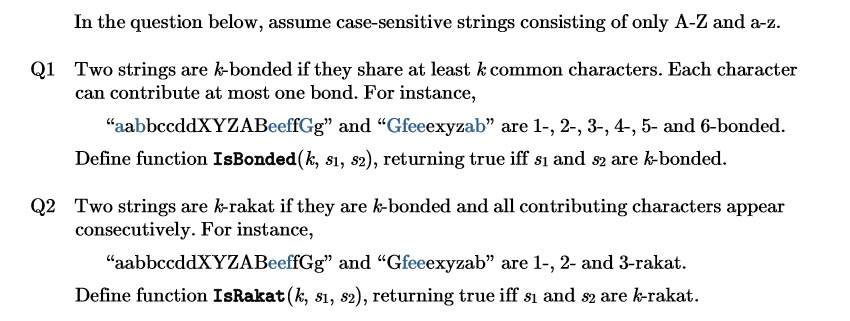Answered step by step
Verified Expert Solution
Question
1 Approved Answer
PLEASE HELP QN2. (Preferably do it in GoLang) In the question below, assume case-sensitive strings consisting of only A-Z and a-z. Q1 Two strings are

PLEASE HELP QN2. (Preferably do it in GoLang)
In the question below, assume case-sensitive strings consisting of only A-Z and a-z. Q1 Two strings are k-bonded if they share at least k common characters. Each character can contribute at most one bond. For instance, "aabbccddXYZABeeffGg" and "Gfeeexyzab are 1-, 2-, 3-, 4-,5- and 6-bonded. Define function IsBonded(k, s, s2), returning true iff si and s2 are k-bonded. Q2 Two strings are k-rakat if they are k-bonded and all contributing characters appear consecutively. For instance, "aabbccddXYZABeeffGg" and "Gfeeexyzab" are 1-, 2- and 3-rakat. Define function Ishakat(k, si, s2), returning true iff si and s2 are k-rakat. In the question below, assume case-sensitive strings consisting of only A-Z and a-z. Q1 Two strings are k-bonded if they share at least k common characters. Each character can contribute at most one bond. For instance, "aabbccddXYZABeeffGg" and "Gfeeexyzab are 1-, 2-, 3-, 4-,5- and 6-bonded. Define function IsBonded(k, s, s2), returning true iff si and s2 are k-bonded. Q2 Two strings are k-rakat if they are k-bonded and all contributing characters appear consecutively. For instance, "aabbccddXYZABeeffGg" and "Gfeeexyzab" are 1-, 2- and 3-rakat. Define function Ishakat(k, si, s2), returning true iff si and s2 are k-rakatStep by Step Solution
There are 3 Steps involved in it
Step: 1

Get Instant Access to Expert-Tailored Solutions
See step-by-step solutions with expert insights and AI powered tools for academic success
Step: 2

Step: 3

Ace Your Homework with AI
Get the answers you need in no time with our AI-driven, step-by-step assistance
Get Started


